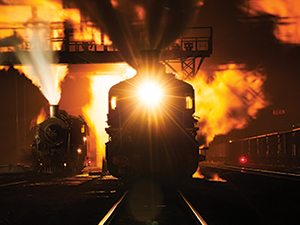
[miningmx.com] – THERE’S been a hullabaloo about the manner in which South African president Jacob Zuma’s administration has selectively adhered to the precepts of the country’s National Development Plan (NDP), especially in its hard-headed pursuit of nuclear power that the NDP warned will be too expensive.
However, one area where NDP recommendations and South African government action appeared to have cohered is in the roll-out of infrastructure insofar as it befell the state-owned transport and logistics utility, Transnet.
In an interview with Mining, acting CEO, Siyabonga Gama, said the seven-year, R300bn roll-out first announced in President Zuma’s State of the Nation speech in February 2012 – which Transnet subsequently dubbed its “Market Demand Strategy’ (MDS) – now stood at R337bn, about 10% more, with R92.8bn in investment already deployed.
What’s interesting to note in this is that while Eskom has buckled under the strain of its expansion, Transnet’s quite different business-to-business model has served it so well that it has reduced its gearing, measured by comparing its net debt to equity. That ratio now stands at 40%, well below 45.9% as of the end of Transnet’s 2014 financial year.
The value of its total assets has doubled in five years to R328bn. “A brand new Transnet is starting to emerge over the last five years,’ said Gama. “We are also punching above our weight recording growth well above the national Gross Domestic Product,’ he said.
The burning question, however, is whether Gama – or Brian Molefe should he decline to take up a permanent role as CEO at Eskom – can keep Transnet’s momentum going against a backdrop of South Africa’s declining rate of economic growth.
Mining activity is but one measure of how this growth is faring, but it’s worth taking a closer look at it if only because Transnet Freight Rail (TFR), which comprises just over half of all of Transnet group revenue, is so closely tied to the sector.
Coal prices have slid from a high of $180 per tonne during 2010 down to around $60/t ($/t) while iron ore prices have fallen from similar levels to below $50/t. Whilst TFR has “take-or-pay’ agreements that protect its revenue, the MDS is betting on coal and iron ore expansion, not the retreat that appears to be currently in motion.
At least two projects in the Waterberg coalfields of Limpopo province, an area TFR is spending billions of rands reticulating, are on the rack with financiers either unable or willing to commit to project funding.
Gama declares himself observant of the situation, but ultimately unfazed by short-term consequences.
“If in 2019, there’s a sudden upturn in the coal or iron ore price, then people will say Transnet has been myopic in failing to provide the capacity for any expansions,’ he said.
“These things happen in markets but Transnet has to invest ahead of the cycle. And when we invest, it’s got to be for the next 30 to 40 years. So the current events in the market are probably just a blip to us,’ he said.
Gama said there are no plans to halt or decelerate the development of phase one of the Waterberg rail development which will see coal capacity increasing to 22 million tonnes per year (mtpa) from only around 4mtpa presently.
And he talks of creating enough capacity for 30mtpa to 40mtpa from the region, and to take on likely exports that could be supplied from Botswana, SA’s landlocked northern brethren.
He’s less forthcoming about his immediate future, however. Asked if he “wants the job’ at Transnet, he replied this was a “difficult and awkward question to answer’.
“I’m just trying as best I can so that the departure of Brian Molefe doesn’t create a vacuum and that should he return he will find a company that is doing the things it was supposed to do,’ he said.










